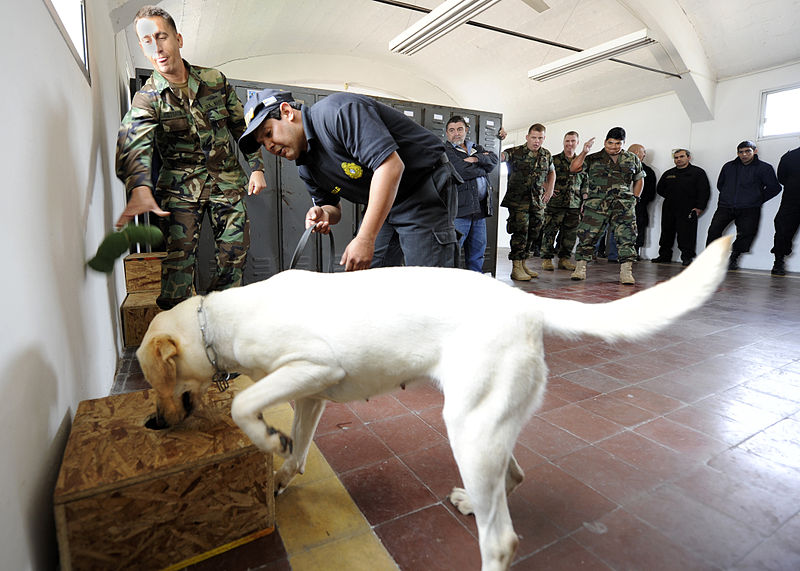Emily Lyon, a 17-year old girl who died at the London O2 Arena last year, had collapsed from an ecstasy overdose, the inquest heard last week. She had taken a quarter of a gram on the way to the venue, and then a further quarter whilst standing in the queue, after seeing sniffer dogs and fearing they would discover the illegal drugs on her person.
After complaining of feeling unwell and overheating, she was rushed to hospital and died around three hours later. A fellow Esher College student, who supplied Emily and her friends with the pills, was arrested the next day and received a 12-month suspended sentence.
In the wake of this tragedy, I would like to examine one element of Emily’s story in particular: the presence of sniffer dogs at the event, which caused her to panic and take her fatal overdose. Specifically, I want to evaluate the police strategy of using sniffer dogs to detect illegal drugs in public spaces and to discuss whether it is an effective way of deterring drug use. Is the strategy really helping or is it actually doing more harm than good?
The aim of sniffer dogs is to deter people from carrying, consuming and selling drugs at nightclubs, festivals and events like the one at the O2. However, there is a little evidence of this actually working and plenty of evidence that these kinds of security measures simply shift the pattern of behaviour slightly. For example, some users, instead of bringing their own and risk being caught, buy inside from dealers. These dealers often bypass security due to the ineffectiveness of the drug dogs or dodgy deals with bouncers. While any drug deal in an unregulated illegal market carries risks, those of with opportunistic dealers inside clubs or festivals, where there is slim likelihood of a repeat purchase, or even the buyer encountering the dealer again, carries increased risks of misselling.
An Australian study, published in January this year, on the deterrent effects of street-level drug law enforcement found that policing with Drug Detection dogs reduce drug possession, but that purchases of drugs within the festival grounds increased and that the overall impacts were small. This backs up what has been suggested for years that increased security just leads people to take drugs before arriving or buying drugs inside, meaning that there is no benefit for safety and no reduction in criminality. It is also important to consider that buying within a nightclub or within festival grounds could be more dangerous for users compared with bringing their own from a “trusted” dealer they have used before. Dealers in nightclubs or one-off events do not need to rely on repeat purchase so are more likely to have lower quality or more toxic drugs than people are used to.
Last year, Islington council ordered extra security measures, including sniffer dogs, for the London nightclub Fabric after four drug-related deaths in three years. However, Fabric won its court appeal against having the dogs at their entrance on the grounds that drug users can still circumvent security. District Judge Gillian Allison said that using sniffer dogs would “undermine” the aim of eliminating drugs. In this way, the court accepted that sniffer dogs do not stop people from taking drugs in the club.
Alan Miller, Chairman of the Night Time Industries Association, was involved in preparing Fabric’s case. He told VolteFace: “Using sniffer dogs at clubs and venues can often be not only ineffective (with a 20% success rate) but also have unintended consequences that some people swallow substances due to panic. This can be fatal and is entirely unproductive. Instead, we should employ harm reduction methods which include information and testing. That’s why we encourage everyone to sign www.savenightline.com to have their voices heard.”
Fiona Measham is conducting research on the efficacy of using drug detection dogs at nightclubs and festivals, their regulation and training in the UK, and the potential impact of their use on drug-related harm in the night time economy. She submitted evidence to Fabric’s licensing appeal in December 2015, where drug detection dogs was the key contested licensing condition, which led the judge to conclude that on balance sniffer dogs could cause more harm than good. Despite the other increased security licensing conditions, Fabric continues not to have sniffer dogs on its doors. She said “it’s a fascinating, under researched area. Sniffer dogs are widely used in the UK, with variable training in the private sector, minimal regulation, and little evaluation of their impact on customers or on drug-related harm”.
So why are sniffer dogs ineffective at deterring drug use? It is partly due to how unreliable they are, often indicating that someone is carrying drugs when they are not and missing many who are. The British Transport Police Operation Shelter, who conducted drugs searches using dogs at Latitude festival in 2008, found that only 12% of those searched as a result of a dog indication were found to be in possession of drugs. Meanwhile, there is plenty of anecdotal evidence of people walking through security “easily” with drugs on their person.
The most extensive study so far on this was conducted by the Privacy Ombudsman of New South Wales in 2006. Their report, based on two years of data representing 10,000 dog searches found that illegal drugs were discovered in just 26% of searches that occurred after a dog indicated that an individual was suspicious. It was also the case that in 60% of the cases where dog-led searches had provided no drugs, the person had been near drugs recently, although the term “recently” could mean up to several months ago. Whilst this means that the failure to find drugs is not necessarily the fault of the dog’s olfactory senses, it does beg the question – how helpful is this? What can police do with the knowledge that someone has been near drugs in the past few months?
On top of all this there is the economic argument against sniffer dogs, which cost a hefty sum and therefore are in no way a cost-effective form of security. There were a number of reports suggesting that the dogs planned for Fabric would have cost £300-a-night. Moreover, it costs thousands of pounds to train a dog to be able to detect drugs and even then, they are far from reliable.
It is also important to consider that unlike in the US and Australia, there are no laws or regulations on the use of sniffer dogs. There are certain guidelines but these are often not adhered to by the police on the ground. For example, police are not supposed to force people to walk past sniffer dogs but can often be found at the top of escalators as people file past. The police do not have the power to require you to submit to a dog sniff, yet treat attempts to avoid a police dog as reasonable grounds for search. It is essentially left to the discretion of each police force to decide for themselves where, when and how they are using sniffer dogs.
Amber Marks is a barrister and expert on sniffer dogs. She warns that this lack of regulation of a form of surveillance sets a precedent for more invasions of privacy and that the legal grey are means the police are just using these tactics with no top-down oversight. And from an outsider’s view, there seems to be fairly capricious decision-making when it comes to assessing which events would benefit from the presence of sniffer dogs.
We contacted the Metropolitan Police to ask, in the light of recent events, whether they consider sniffer dogs to be effective at preventing drug use at public events. They replied stating that, as such events are nationwide, we should refer our enquiry to the National Police Chiefs Council (NPCC). However, an NPCC spokesman was equally equivocal, saying: “This isn’t really an issue that we could give conclusive national position on. The decision to use sniffer dogs is an operational one and would be made by an individual force depending on the case”.
When pressed, the spokesman added: “We do think they can be useful, but the way they are used depends on the operational context”. He also emphasised that drug dogs are “not widely used or a nationally mandated tactic for drug enforcement.”
Finally, when looking at the effects of sniffer dogs, we do need to remember that there are many occasions when the presence of sniffer dogs can cause serious harm, such as in Emily Lyon’s case. The sight of the sniffer dogs caused her to double her ecstasy intake so as to not get in trouble, which ended up leading to her death. This is not an isolated case either – it is fairly commonplace to panic-take drugs to avoid being caught and consequently end up in hospital or worse. A tactic that is supposed to make people safer is far too often the trigger for things to get much worse, especially when dogs are deployed without an amnesty bin, leaving people in a position where they think there is no option other than to take their drugs.
As with any discussion about safety and security regarding drugs, we need to face up to the fact that these problems are far too systemic to be fixed by simply tightening security. It will never be possible to catch everything and everyone, and to do so would be a gross invasion of privacy, so perhaps it is unsurprising that sniffer dogs don’t deter drug use to any great effect. At best, they may slightly reduce the amount of drugs coming into venues. At worst, they harm the people they seek to protect, by causing them to buy drugs from opportunistic dealers inside venues or panic-take large doses out of fear of being caught in possession.
Read Release’s guide to sniffer dogs and your rights here.
Words by Abbie Llewelyn. Tweets @Abbiemunch



